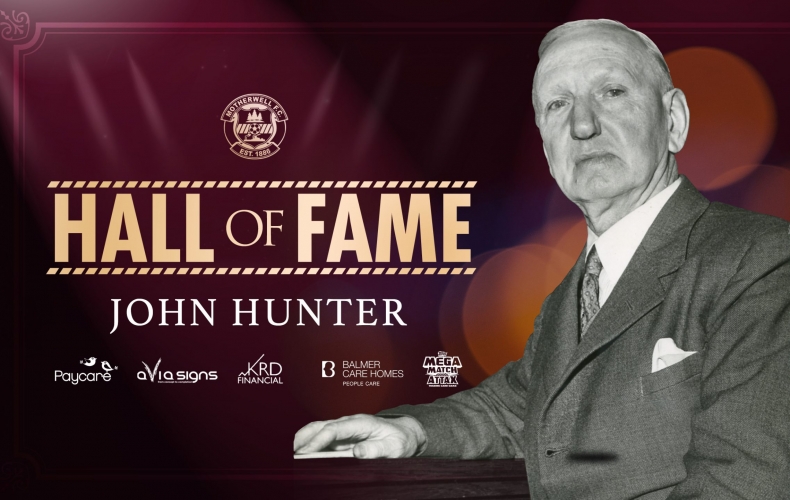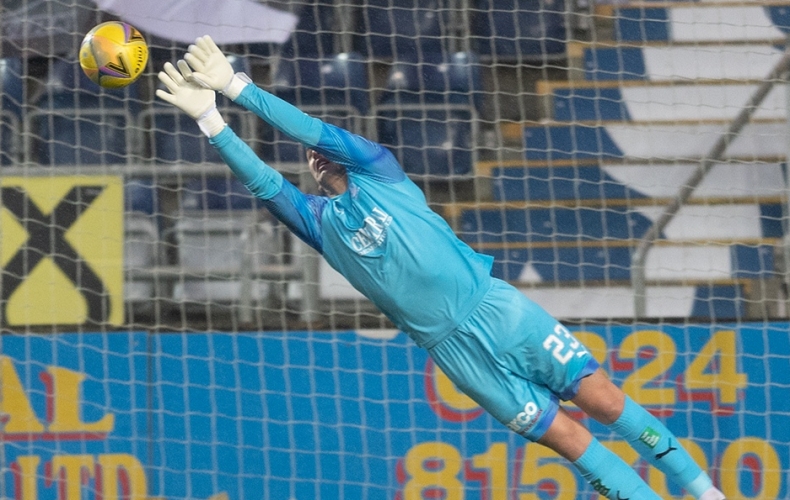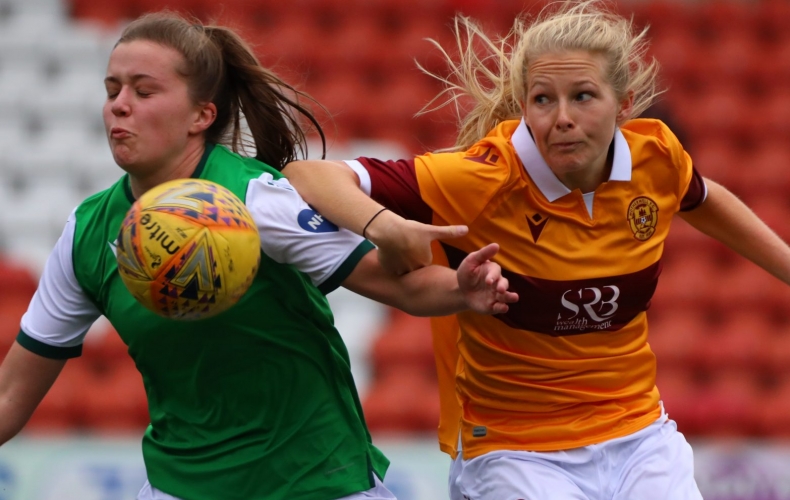Our first inductee to the Motherwell FC Hall of Fame in 2020 is John Hunter.
We will honour the class of 2020 with a unique virtual induction event this winter by means of a special live, free-to-air, online event.
We are also once again launching a special fans’ vote for a fifth inductee.
You can join in the vote by nominating any individual from any era in Motherwell’s past – player, manager or official – who you think is worthy of being included in the 2020 class.
Click here to vote for who you want to see in the Motherwell FC Hall of Fame.
John Bryson Hunter was born in Johnstone, Renfrewshire on 6 April 1878. Motherwell Football Club hadn’t been formed yet, but the boy who would affectionately become known as ‘Sailor’ would grow up to become its greatest influence.
At the age of 18, he signed for Paisley side Abercorn, who had been relegated to the second tier the previous season. While Abercorn did not improve at all during his time there, Hunter was soon snapped up by English giants Liverpool.
He became part of the Liverpool side that won their first-ever First Division Championship in 1901. However a year later, after he failed to settle in Merseyside, he was persuaded to return to Scotland, signing for Hearts for £300 in a joint transfer with Tom Robertson.
He was to help the Jambos reach, but lose, the 1903 Scottish Cup Final against Rangers.
In 1904 he joined Woolwich Arsenal in a £165 transfer, playing 22 times for them in 1904/05 season, before joining Portsmouth, then of the Southern League. But it was only when he joined Dundee in 1907 that he came into his own, moving from left midfield to centre forward, becoming a quite prolific goalscorer, and earning his only cap for Scotland in a 3-2 defeat by Wales down in Wrexham in March 1909.
In the 1910 Scottish Cup Final, Hunter’s Dundee were up against a strong Clyde team who had knocked out Celtic 3-1 in the semi-final and were 2-0 up in the final with six minutes to play. Sailor scored a goal to give Dundee hope then, two minutes later, the Dark Blues equalised, and the teams had to do it all again. The first replay ended in a 0-0 draw but Dundee won the second replay 2-1 with Hunter notching the winner. It was to be his finest moment as a player in Scotland.
He signed for Clyde in September 1910, but an injury forced him to retire six months later, without making a single appearance for the Bully Wee.
Two months later, in April 1911, Hunter was appointed the first-ever manager at Fir Park at the age of 32, and so the man who would transform our beloved club began an incredible journey that would leave his name indelibly etched into the fabric of Motherwell FC history.
The Steelmen had finished second bottom of the First Division in season 1910/11, just above relegated Queen’s Park. Hunter would improve their position slightly in the following season, although the highlight was the reserve side winning their league title for the first time.
Motherwell improved steadily on the pitch over the next few years, as did John Hunter’s reputation off it, borne out by the directors handing him the secretary’s job in addition to his managerial duties midway through the 1912/13 season. Then, on 23 August 1913, the club sported the famous claret and amber colours for the first time in a 1-1 draw at home to Celtic.
In August 1916, Hunter gave a debut to a young centre forward signed from Parkhead Juniors, Hughie Ferguson, who hit a double against Raith Rovers and followed it up with a hat trick two weeks later against Dundee. It was to prove an inspirational signing as Ferguson was Motherwell’s top scorer in every one of the nine seasons he played at Fir Park, amassing a terrific 362 goals and to this day he remains Motherwell’s all-time top scorer, a record unlikely to be surpassed. He was also the top scorer in the Scottish Football League in seasons 1917/18, 1919/20 & 1920/21.
For the next four campaigns, Motherwell never finished lower than fifth in the league but, over time, financial restraints began to tell on the club. Local unemployment was higher than it had ever been, crowds were down, and the club had to abandon their reserve team.
Motherwell began to slip in the league and they finished the 1924/25 third from bottom, on the same points total as the two teams immediately below them. Indeed, it was only Ferguson’s goals that kept the club in the top flight. The following season started pretty well for Motherwell, but soon into the season Ferguson was sold to Cardiff City for £5,000, putting paid, it seemed, to the club’s hopes for the near future.
Mr Hunter though had identified an instant replacement for Ferguson in the shape of another signed from Parkhead Juniors, Willie MacFadyen, who would go on to more than justify the manager’s faith in him. He took Ferguson’s number nine shirt and spookily, repeated his predecessor’s debut feat by firing a double past Raith Rovers in a 5-0 romp.
Motherwell finished fifth that season and for the next eight seasons, they would not finish lower than third, with a league title to celebrate in 1931/32.
The original “famous five” adorned Fir Park in this era, with the names, Murdoch, McMenemy, MacFadyen, Stevenson and Ferrier tripping off the tongues of the Motherwell faithful, as the men in claret and amber played a brand of football that had the world drooling in anticipation whenever Motherwell came to town.
It was at this time that Mr Hunter saw the advantage of taking such a football team abroad, and was the architect of four successful world-wide tours undertaken by the club, played to big crowds, to boost finances.
The summer of 1927 saw Motherwell tour Spain, beating Real Madrid to win the King of Spain Cup, and drawing with Barcelona to secure the Barcelona Cup. The following year, ‘Well headed to South America with matches in Argentina, Uruguay and Brazil yielding more silverware yet, and, 1931 and 1934 saw the Steelmen visit South Africa in the most arduous of tours.
During the 1931 tour, 15 players played 15 games within 42 days, losing just the once, with MacFadyen scoring 30 of the 57 goals Motherwell rattled past the opposition.
It proved to be the perfect preparation for the new campaign, which would see the Steelmen scoring an incredible 119 goals in 38 league games to finally secure the league title, after twice narrowly finishing runners up.
Motherwell became the first club to win the Championship outside the Old Firm in almost 30 years and whilst using only 19 players.
Despite the foreign tours being money-spinning for the club, Hunter insisted on the board curtailing them in future years, which they did into four or five games at a time, and a little closer to Lanarkshire.
It was also during this period that “Sailor” instilled a cup fighting spirit at the club, resulting in three Scottish Cup final appearances, the first in the club’s history.
Hunter would remain as secretary/manager at Fir Park until the summer of 1946 when George Stevenson, inside left and playmaker of the team which won the Championship, would take over the managerial hot seat, leaving Hunter to the then important secretary role.
He oversaw the team winning its first-ever domestic cup, the League Cup, by beating the infamous ‘Famous Five’ Hibernian team 3-0 at Hampden Park in October 1950.
Two years later, in 1952, the Fir Parkers would win the Scottish Cup for the first time, and the first stop for the victorious Motherwell team after lifting the old trophy was Fir Park to show Mr Hunter, who had been unable to witness the Hampden showpiece due to a deterioration of his eyesight.
Sailor found it hard to leave Fir Park and remained as club secretary until his retirement in 1959 at the age of 80. After 48 years service, the club granted him a weekly pension of £10 a week upon his retirement.
The legend that was John “Sailor” Hunter passed away, aged 87, in January 1966. It’s pretty safe to say that Motherwell Football Club would not be in the prominent position it is today within Scottish football, were it not for the vision, wisdom and influence of John Hunter.
The original, and only, Mr Motherwell FC, the East Stand at Fir Park was renamed after him in November 2016 as a permanent tribute to his unrivalled contribution.






























